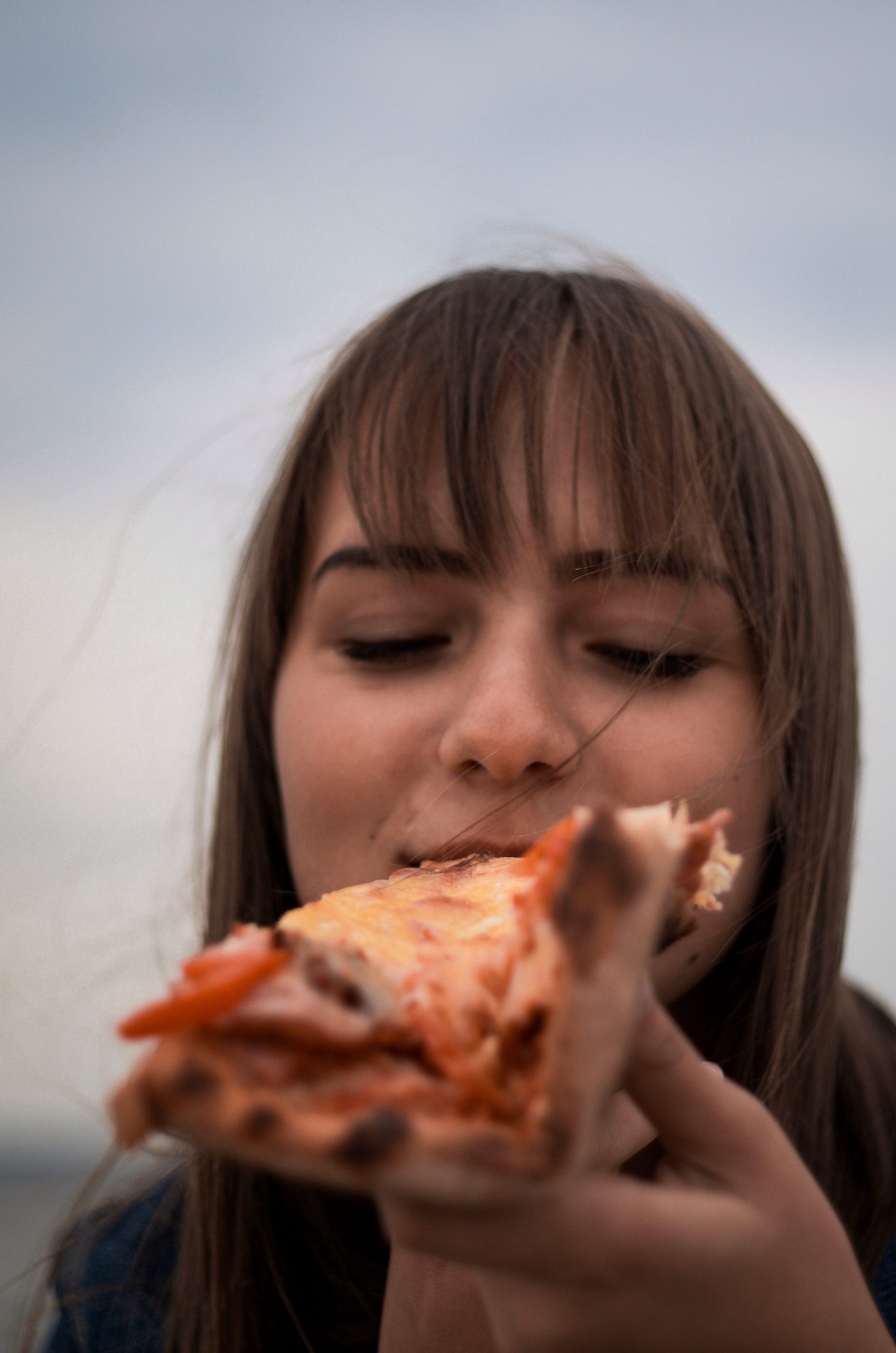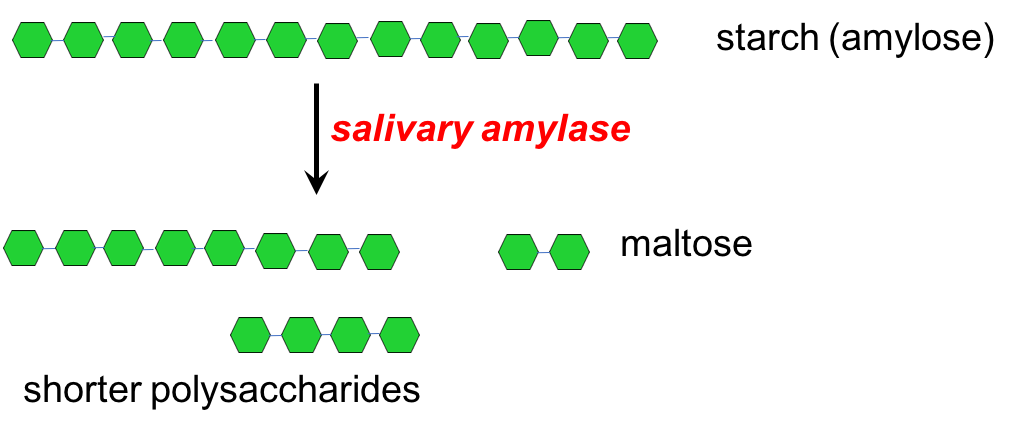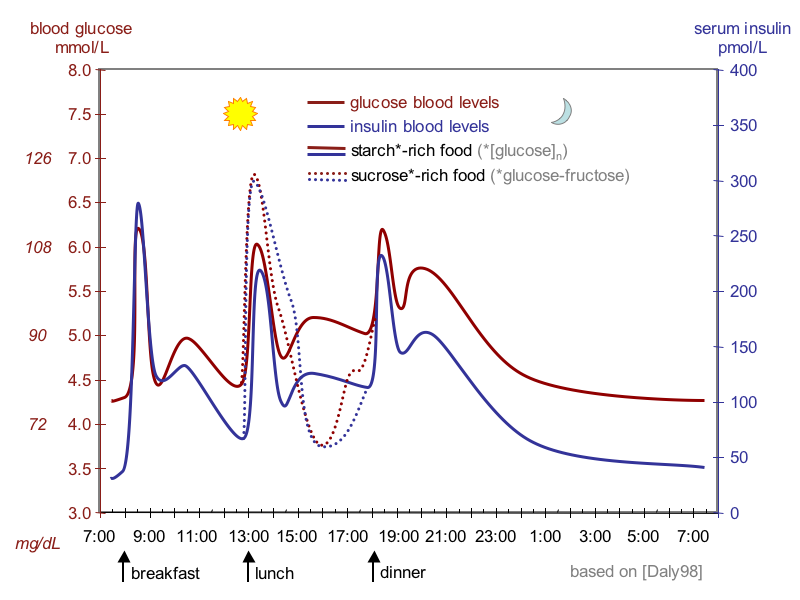Unit 4 – Carbohydrates
4.4 Carbohydrate Digestion, Absorption, and Regulation

Imagine taking a bite of pizza. It tastes amazing, but it’s also full of fuel for your body, much of it in the form of carbohydrates.
What types of carbohydrates would you find in that bite?
- Lactose from the cheese
- Sucrose, glucose, and fructose from the naturally-occurring sugars in the tomatoes, as well as sugar that may have been added to the sauce
- Starch in the flour used to make the crust
- Fiber in the flour, tomatoes, and basil
- use these food carbohydrates in your body, you first need to digest them. Last unit, we explored the gastrointestinal system and the basic process of digestion. Now that you know about the different types of carbohydrates, we’ll take a closer look at how these molecules are digested as they travel through the GI system.
Carbohydrate Digestion
In the image below, follow the numbers to see what happens to carbohydrates at each site of digestion. (Or watch the 3:13 minute video “Carbohydrate Digestion and Absorption.” by What’s Up Dude. August 28, 2018)

Digestion in the Oral Cavity (Mouth)
Within the oral cavity (1), as you chew your bite of pizza, you’re using mechanical digestion to begin to break it into smaller pieces and mix it with saliva, produced by several salivary glands in the oral cavity.
Some enzymatic digestion of starch occurs in the mouth, due to the action of the enzyme salivary amylase. This enzyme starts to break the long glucose chains of starch into shorter chains, some as small as maltose. (The other carbohydrates in the bread don’t undergo any enzymatic digestion in the mouth.)

Digestion in the Stomach
The low pH in the stomach (2) inactivates salivary amylase, so it no longer works once it arrives at the stomach. Although there’s more mechanical digestion in the stomach, there’s little chemical digestion of carbohydrates here.
Digestion in the Small intestine
Most carbohydrate digestion occurs in the small intestine (3), thanks to a suite of enzymes. Pancreatic amylase is secreted from the pancreas into the small intestine, and like salivary amylase, it breaks starch down to small oligosaccharides (containing 3 to 10 glucose molecules) and maltose.

The rest of the work of carbohydrate digestion is done by enzymes produced by the enterocytes, the cells lining the small intestine. When it comes to digesting your slice of pizza, these enzymes will break down the maltose formed in the process of starch digestion, the lactose from the cheese, and the sucrose present in the sauce.
Maltose is digested by maltase, forming 2 glucose molecules.

Lactose is digested by lactase, forming glucose and galactose.

Sucrose is digested by sucrase, forming glucose and fructose.

(Recall that if a person is lactose intolerant, they don’t make enough lactase enzyme to digest lactose adequately. Therefore, lactose passes to the large intestine. There it draws water in by osmosis and is fermented by bacteria, causing symptoms such as flatulence, bloating, and diarrhea.)By the end of this process of enzymatic digestion, we’re left with three monosaccharides: glucose, fructose, and galactose. These can now be absorbed across the enterocytes of the small intestine and into the bloodstream to be transported to the liver.
Digestion in the Colon (Large Intestine)
Any carbohydrates that weren’t digested in the small intestine—mainly fiber—pass into the colon (4), but there’s no enzymatic digestion of these carbohydrates here. Instead, bacteria living in the large intestine, sometimes called our gut microbiota, ferment these carbohydrates to feed themselves. Fermentation causes gas production, and that’s why we may experience bloating and flatulence after a particularly fibrous meal. Fermentation also produces short-chain fatty acids, which our large intestine cells can use as an energy source. Over the last decade or so, more and more research has shown that our gut microbiota are incredibly important to our health, playing important roles in the function of our immune response, nutrition, and risk of disease. A diet high in whole food sources of fiber helps to maintain a population of healthy gut microbes.
Carbohydrate Absorption
Digestion and absorption of carbohydrates in the small intestine are depicted in a very simplified schematic below. (Remember that the inner wall of the small intestine is actually composed of large circular folds, lined with many villi, the surface of which are made up of microvilli. All of this gives the small intestine a huge surface area for absorption.)

Fructose and galactose are converted to glucose in the liver. Once absorbed carbohydrates pass through the liver, glucose is the main form of carbohydrate circulating in the bloodstream.
Insulin and Glucagon Control Blood Glucose Levels
The hormones insulin and glucagon control glucose levels in the blood. Both are produced by the pancreas and released into the bloodstream in response to changes in blood glucose. (This 3:12 minute TED Ed video on How does your pancreas work? includes an overview of how the pancreas makes insulin.)
- Insulin is released when blood glucose is high and causes cells around the body to take up glucose from the blood, resulting in lowering blood glucose concentrations.
- Glucagon is released when blood glucose is low and causes glycogen in the liver to break down, releasing glucose into the blood, resulting in raising blood glucose concentrations. (Remember that glycogen is the storage form of glucose.)
Figure 4:15 shows blood glucose and insulin levels throughout a day, including three meals. When glucose rises, it is followed immediately by a rise in insulin, and glucose soon drops again. The figure also shows the difference between consuming a sucrose-rich food and a starch-rich food. The sucrose-rich food results in a greater spike in both glucose and insulin. Because more insulin is required to handle that spike, it also causes a sharper decline in blood glucose. This is why eating a lot of sugar all at once may increase energy in the short-term, but soon after may make you feel like taking a nap!

In addition to its role in glucose uptake into cells, insulin also stimulates glycogen and fat synthesis as described above. Athletes often eat a high carb food after exercise to replenish the glycogen stores used during physical activity. Insulin also increases protein synthesis. However in a sedentary person, the rise in insulin cause your body to make too much fat, contributing to obesity.
On the other hand, when blood glucose falls, glucagon is released from the pancreas into the bloodstream. In liver cells, it stimulates the breakdown of glycogen, releasing glucose into the blood.
VIDEO: This second 5 minute TED Ed video on “How Do Carbohydrates Impact Your Health” begins with a review of carbs and with an explanation of insulin.
Self-Review Questions
References:
- Klein, S., Cohn, S. M., & Alpers, D. H. (1999). The Alimentary Tract in Nutrition. In Modern Nutrition in Health and Disease (9th ed.). Baltimore: Lippincott Williams and Wilkins.
- Harvard T.H. Chan School of Public Health. (n.d.). The Microbiome. Retrieved November 15, 2019, from The Nutrition Source website: https://www.hsph.harvard.edu/nutritionsource/microbiome/
Image Credits:
- “Pizza” photo by Kate Voytsutskaya on Unsplash
- Figure 4.9. “The digestive system” by Alice Callahan is licensed under CC BY 4.0 / A derivative from the original work
- Figure 4.10. “Carbohydrate digestion schematics” by Alice Callahan is licensed under CC BY-NC-SA 4.0
- Figure 4.11. “Starch digestion” by Alice Callahan is licensed under CC BY-NC-SA 4.0
- Figure 4.12. “Disaccharide digestion” by Alice Callahan is licensed under CC BY-NC-SA 4.0
- Figure 4.13. “Carbohydrate absorption” by Alice Callahan is licensed under CC BY-NC-SA 4.0
- Table 4.3. “Carbohydrate and digestion summary chart” by Tamberly Powell is licensed under CC BY-NC-SA 4.0

